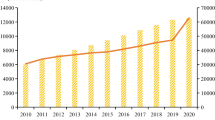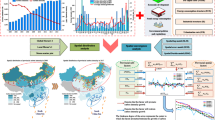Abstract
Due to the imbalance of technological level and industrial structure in regional economic development, the same carbon source can bring differentiated carbon emission levels in different regions, thus making the carbon emission show significant regional differences. In order to explore the regional differences in China’s provincial carbon emission intensity and the effect of relevant influencing factors, this paper combines EKC model and STIRPAT model to conduct research. Using carbon emission intensity and other influencing factors of China’s 30 provinces ranging from 2005 to 2017 to construct a panel data, the authors use exploratory spatial data analysis and Spatial Durbin Model to study the spatial effect of carbon emission intensity in China’s provincial regions and the impact of different development factors on carbon emission intensity. The results show that from 2005 to 2017, China’s carbon emission intensity gradually declined from east to west and from south to north. The inter-provincial carbon emission intensity of China presents an agglomeration effect in space, and the agglomeration effect gradually weakens with time. In addition, reducing energy intensity can reduce carbon emission intensity to a large extent. By optimizing industrial structure, increasing the degree of foreign trade and promoting financial development, carbon emission intensity can also be inhibited. Therefore, reducing the energy intensity of various industries and establishing inter-regional carbon emission cooperation mechanism will be effective to control the carbon emission intensity.



Similar content being viewed by others
Data availability
Some or all data, models, or code generated or used during the study are available from the corresponding author by request.
Abbreviations
- DA:
-
decomposition analysis
- CI:
-
carbon emission intensity
- P:
-
population
- PGDP:
-
economic development
- TP:
-
technological progress
- EI:
-
energy intensity
- OPEN:
-
economic opening rate
- UR:
-
urbanization rate
- IS:
-
industrial structure
- GI:
-
government intervention
- FD:
-
financial development
- ESDA:
-
exploratory spatial data analysis
- SDM:
-
Spatial Durbin Model
- SAR:
-
Spatial Autoregressive Model
- SEM:
-
Spatial Error Model
References
Ali HS, Abdul-Rahim AS, Ribadu MB (2017) Urbanization and carbon dioxide emissions in Singapore: evidence from the ARDL approach. Environ Sci Pollut Res 24(2):1967–1974
Amri F (2018) Carbon dioxide emissions, total factor productivity, ICT, trade, financial development, and energy consumption: testing environmental Kuznets curve hypothesis for Tunisia. Environ Sci Pollut Res 25(33):33691–33701
Anser MK (2019) Impact of energy consumption and human activities on carbon emissions in Pakistan: application of STIRPAT model. Environ Sci Pollut Res 26(13):13453–13463
Appiah K, Du J, Yeboah M, Appiah R (2019) Causal correlation between energy use and carbon emissions in selected emerging economies panel model approach. Environ Sci Pollut Res 26(8):7896–7912
Aragao LEOC, Anderson LO, Fonseca MG, Rosan TM, Vedovato LB, Wagner FH, Saatchi S (2018) 21st Century drought-related fires counteract the decline of Amazon deforestation carbon emissions. Nat Commun 9
Arora VK, Melton JR (2018) Reduction in global area burned and wildfire emissions since 1930s enhances carbon uptake by land. Nat Commun 9
Asumadu-Sarkodie S, Owusu PA (2016) Carbon dioxide emissions, GDP, energy use, and population growth: a multivariate and causality analysis for Ghana, 1971-2013. Environ Sci Pollut Res 23(13):13508–13520
Bi C, Zeng J (2019) Nonlinear and spatial effects of tourism on carbon emissions in China: a spatial econometric approach. Int J Environ Res Public Health 16(18):3353
Can M, Gozgor G (2017) The impact of economic complexity on carbon emissions: evidence from France. Environ Sci Pollut Res 24(19):16364–16370
Cetin M, Ecevit E, Yucel AG (2018) The impact of economic growth, energy consumption, trade openness, and financial development on carbon emissions: empirical evidence from Turkey. Environ Sci Pollut Res 25(36):36589–36603
Chelly A, Nouira I, Frein Y, Hadj-Alouane AB (2019) On the consideration of carbon emissions in modelling-based supply chain literature: the state of the art, relevant features and research gaps. Int J Prod Res 57(15–16):4977–5004
Dai S, Zuo S, Ren Y (2020) A spatial database of CO2 emissions, urban form fragmentation and city-scale effect related impact factors for the low carbon urban system in Jinjiang city, China. Data Brief 29:105274
Dogan E, Seker F (2016) An investigation on the determinants of carbon emissions for OECD countries: empirical evidence from panel models robust to heterogeneity and cross-sectional dependence. Environ Sci Pollut Res 23(14):14646–14655
Ehigiamusoe KU, Lean HH (2019) Effects of energy consumption, economic growth, and financial development on carbon emissions: evidence from heterogeneous income groups. Environ Sci Pollut Res 26(22):22611–22624
Gozgor G (2017) Does trade matter for carbon emissions in OECD countries? Evidence from a new trade openness measure. Environ Sci Pollut Res 24(36):27813–27821
Griffin PW, Hammond GP, Norman JB (2018) Industrial energy use and carbon emissions reduction in the chemicals sector: a UK perspective. Appl Energy 227:587–602
Gul S, Zou X, Hassan CH, Azam M, Zaman K (2015) Causal nexus between energy consumption and carbon dioxide emission for Malaysia using maximum entropy bootstrap approach. Environ Sci Pollut Res 22(24):19773–19785
Guo X, Ren D, Shi J (2016) Carbon emissions, logistics volume and GDP in China: empirical analysis based on panel data model. Environ Sci Pollut Res 23(24):24758–24767
Haites E (2018) Carbon taxes and greenhouse gas emissions trading systems: what have we learned? Clim Pol 18(8):955–966
Hanif I (2018) Impact of economic growth, nonrenewable and renewable energy consumption, and urbanization on carbon emissions in sub-Saharan Africa. Environ Sci Pollut Res 25(15):15057–15067
Haszeldine RS, Flude S, Johnson G, Scott V (2018) Negative emissions technologies and carbon capture and storage to achieve the Paris Agreement commitments. Philos Trans A Math Phys Eng Sci 376(2119):20160447
Ismael M, Srouji F, Boutabba MA (2018) Agricultural technologies and carbon emissions: evidence from Jordanian economy. Environ Sci Pollut Res 25(11):10867–10877
Karakaya E, Bostan A, Ozcag M (2019) Decomposition and decoupling analysis of energy-related carbon emissions in Turkey. Environ Sci Pollut Res 26(31):32080–32091
Khan MK, Teng J-Z, Khan M (2019) Effect of energy consumption and economic growth on carbon dioxide emissions in Pakistan with dynamic ARDL simulations approach. Environ Sci Pollut Res 26(23):23480–23490
Kok AG, Shang K, Yucel S (2018) Impact of electricity pricing policies on renewable energy investments and carbon emissions. Manag Sci 64(1):131–148
Matthews HD, Zickfeld K, Knutti R, Allen MR (2018) Focus on cumulative emissions, global carbon budgets and the implications for climate mitigation targets. Environ Res Lett 13(1)
Narassimhan E, Gallagher KS, Koester S, Alejo JR (2018) Carbon pricing in practice: a review of existing emissions trading systems. Clim Pol 18(8):967–991
Naz S, Sultan R, Zaman K, Aldakhil AM, Nassani AA, Abro MMQ (2019) Moderating and mediating role of renewable energy consumption, FDI inflows, and economic growth on carbon dioxide emissions: evidence from robust least square estimator. Environ Sci Pollut Res 26(3):2806–2819
Pata UK (2018) The effect of urbanization and industrialization on carbon emissions in Turkey: evidence from ARDL bounds testing procedure. Environ Sci Pollut Res 25(8):7740–7747
Peters GP, Andrew RM, Canadell JG, Fuss S, Jackson RB, Korsbakken JI, Le Quéré C, Nakicenovic N (2017) Key indicators to track current progress and future ambition of the Paris Agreement. Nat Clim Chang 7:118–122
Raggad B (2018) Carbon dioxide emissions, economic growth, energy use, and urbanization in Saudi Arabia: evidence from the ARDL approach and impulse saturation break tests. Environ Sci Pollut Res 25(15):14882–14898
Sarkar B, Omair M, Choi SB (2018) A multi-objective optimization of energy, economic, and carbon emission in a production model under sustainable supply chain management. Appl Sci-Basel 8(10)
Shao L, Li Y, Feng K, Meng J, Shan Y, Guan D (2018) Carbon emission imbalances and the structural paths of Chinese regions. Appl Energy 215:396–404
Wang Y, Zheng Y (2019) The significance of emission trading system from the perspective of environmental regulation - based on the analysis of China’s environmental pollution control data. Paper presented at the 2019 5th international conference on energy materials and environment engineering, Lumpur
Wang F, Fan W, Liu J, Wang G, Chai W (2020) The effect of urbanization and spatial agglomeration on carbon emissions in urban agglomeration. Environ Sci Pollut Res
Yi Y, Li J (2018) Cost-sharing contracts for energy saving and emissions reduction of a supply chain under the conditions of government subsidies and a carbon tax. Sustainability 10(3)
Zheng J, Mi Z, Coffman DM, Milcheva S, Shan Y, Guan D, Wang S (2019) Regional development and carbon emissions in China. Energy Econ 81:25–36
Zhou Z, Liu C, Zeng X, Jiang Y, Liu W (2018) Carbon emission performance evaluation and allocation in Chinese cities. J Clean Prod 172:1254–1272
Zhu X, Zhang T, Gao W, Mei D (2020) Analysis on spatial pattern and driving factors of carbon emission in urban–rural fringe mixed-use communities: cases study in East Asia. Sustainability 12(8):3101
Acknowledgments
We express sincere gratitude to the potential reviewers for their help to improve the quality of the manuscript.
Funding
This research was supported by the innovation and entrepreneurship training programs for Chinese college students (201910488002X) and graduate students (JCX201958).
Author information
Authors and Affiliations
Contributions
Yingdong Wang is responsible for the original draft editing and reviewing; Yueming Zheng is responsible for the project administration and reviewing.
Corresponding author
Ethics declarations
Competing interests
The authors declare that they have no competing interests.
Ethics approval and consent to participate
I confirm that all the research meets ethical guidelines and adheres to the legal requirements of the study country.
Consent for publication
On behalf of all authors, I declare that this manuscript is the authors’ original work and has not been published nor has it been submitted simultaneously elsewhere; and all authors have checked the manuscript and have agreed to the publication on ESPR.
Additional information
Responsible Editor: Philippe Garrigues
Publisher’s note
Springer Nature remains neutral with regard to jurisdictional claims in published maps and institutional affiliations.
Supplementary information
ESM 1
(DOCX 15 kb)
Rights and permissions
About this article
Cite this article
Wang, Y., Zheng, Y. Spatial effects of carbon emission intensity and regional development in China. Environ Sci Pollut Res 28, 14131–14143 (2021). https://doi.org/10.1007/s11356-020-11557-7
Received:
Accepted:
Published:
Issue Date:
DOI: https://doi.org/10.1007/s11356-020-11557-7




